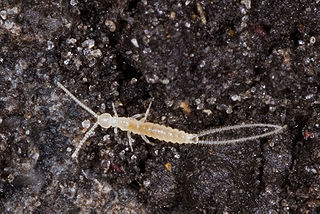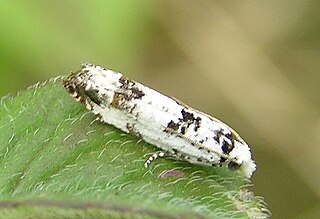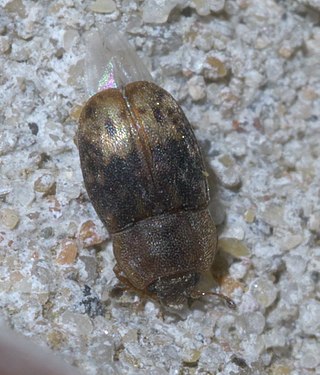
The lovebug is a species of march fly found in parts of Central America and the southeastern United States, especially along the Gulf Coast. It is also known as the honeymoon fly or double-headed bug. During and after mating, matured pairs remain together, even in flight, for up to several days.

Campodea is a genus of small, white, bristle-tailed arthropods in the order Diplura. The best known species, Campodea staphylinus, has a wide distribution across much of Europe. It lives in damp places under stones, fallen trees, or in rotten wood and leaves. Although blind, it immediately crawls away on exposure to the light into the nearest crevice or other sheltered spot, feeling the way with its antennae. There are at least 130 described species in Campodea.

Coleophora is a very large genus of moths of the family Coleophoridae. It contains some 1,350 described species. The genus is represented on all continents, but the majority are found in the Nearctic and Palaearctic regions. Many authors have tried splitting the genus into numerous smaller ones, but most of these have not become widely accepted.

The Eulophidae is a large family of hymenopteran insects, with over 4,300 described species in some 300 genera. The family includes the genus Elasmus, which used to be treated as a separate family, "Elasmidae", and is now treated as a subfamily of Eulophidae. These minute insects are challenging to study, as they deteriorate rapidly after death unless extreme care is taken, making identification of most museum specimens difficult. The larvae of very few species feed on plants, but the majority are primary parasitoids on a huge range of arthropods at all stages of development. They are exceptional in that they are one of two hymenopteran families with some species that are known to parasitize thrips. Eulophids are found throughout the world in virtually all habitats.

Thermobia is a genus of primitive insects belonging to the family Lepismatidae. The genus was erected by Ernst Evald Bergroth in 1890. By far the best known member of the genus is the firebrat, which is often seen in warm places indoors such as bakeries.

Schinia, commonly called flower moths, is a large genus of moths belonging to the family Noctuidae. The genus has a Holarctic distribution with the vast majority of species being found in North America, many with a very restricted range and larval food plant.
Amydria is a genus of moths in the family Acrolophidae.

Eucosma is a very large genus of moths belonging to the family Tortricidae. Some taxonomies place a number of species in the genus Eucopina. The genus has a Holarctic and Indomalayan distribution. Even in well-studied Europe and North America, new species are still regularly discovered. There are at least 670 described species in Eucosma worldwide.

Nomophila is a genus of moths of the family Crambidae.

Alypia is a genus of moths in the family Noctuidae.

Eucosmomorpha is a genus of moths belonging to the subfamily Olethreutinae of the family Tortricidae.

Omosita is a genus of sap beetles, erected by Wilhelm Ferdinand Erichson in 1843.
Smicronyx is a genus of snout and bark beetles in the family Curculionidae. There are at least 70 described species in Smicronyx.
Bravoceratops is a genus of large chasmosaurine ceratopsid dinosaur that lived approximately 70 million years ago, and is known from the Late Cretaceous Javelina Formation in what is now Texas, United States.
The Cremifaniidae are a very small family of acalyptrate flies with only 4 described species worldwide. All species are considered rare, and nothing is known of their life history. They were formerly placed in the family Chamaemyiidae.

Gryllidea is an infraorder that includes crickets and similar insects in the order Orthoptera. There are two superfamilies, and more than 6,000 described species in Gryllidea.

Smiliinae is a subfamily of treehoppers in the family Membracidae. These are bugs and include about 100 genera in 10 tribes.

Trierarchuncus is a monotypic genus of alvarezsaurid theropod which includes a single species, Trierarchuncus prairiensis, which is known from fossils found in deposits of the Hell Creek Formation in Montana. It is the youngest known alvarezsaurid and one of the last non-avian dinosaurs, going extinct during the Cretaceous–Paleogene extinction event, which occurred approximately 66 million years ago.

Smilia is a genus of treehoppers belonging to the tribe Smiliini in the subfamily Smiliinae. There are at least two described species in the genus.
Sayiana is a genus of planthoppers belonging to the subfamily Otiocerinae.













